AUDI A4 AVANT 2008 Owners Manual
Manufacturer: AUDI, Model Year: 2008, Model line: A4 AVANT, Model: AUDI A4 AVANT 2008Pages: 368, PDF Size: 46.19 MB
Page 301 of 368
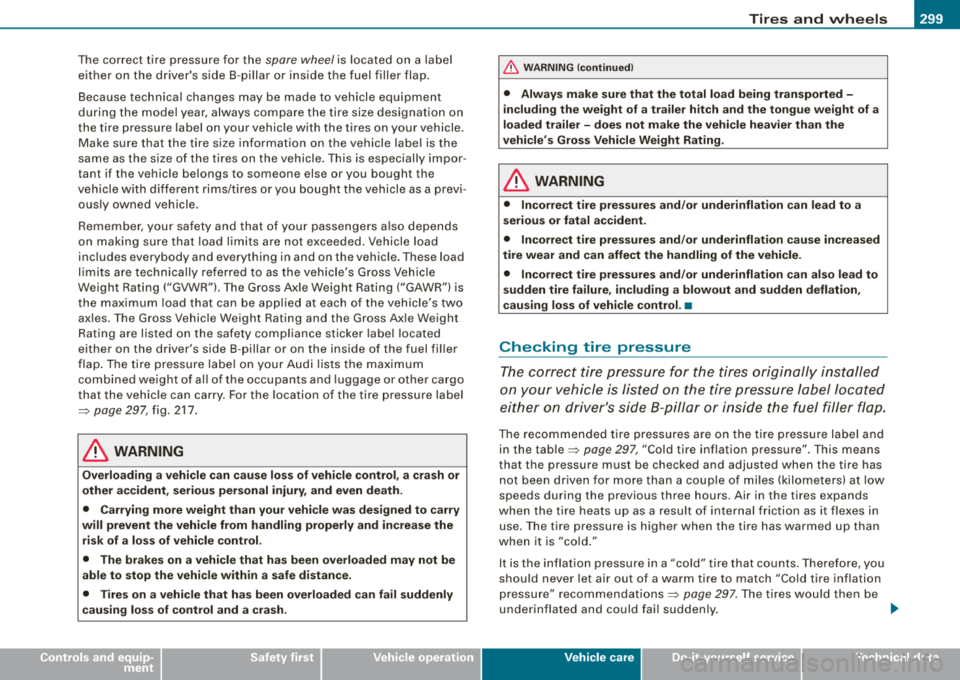
________________________________________________ T_ i
_ r_e _s_ a_n_ d_ w_ h_ e_e _ l_s __ fflll
The correct tire pressure for the spore wheel is located on a label
either on the driver's side B-pillar or inside the fuel filler flap.
Because technical changes may be made to vehicle equipment
during the model year, always compare the tire size designation on
the tire pressure label on your vehicle with the tires on your vehicle.
Make sure that the tire size information on the vehicle label is the
same as the size of the tires on the vehicle. This is especially impor
tant if the vehicle belongs to someone else or you bought the
vehicle with different rims/tires or you bought the vehicle as a previ
ously owned vehicle .
Remember, your safety and that of your passengers also depends
on making sure that load limits are not exceeded. Vehicle load
includes everybody and everything in and on the vehicle. These load
limits are technically referred to as the vehicle's Gross Vehicle
Weight Rating ("GVWR"l. The Gross Axle Weight Rating ("GAWR"l is
the maximum load that can be applied at each of the vehicle's two
axles. The Gross Vehicle Weight Rating and the Gross Axle Weight
Rating are listed on the safety compliance sticker label located
either on the driver's side B-pillar or on the inside of the fuel filler
flap. The tire pressure label on your Audi lists the maximum
combined weight of all of the occupants and luggage or other cargo
that the vehicle can carry. For the location of the tire pressure label
=> page 297, fig. 217.
& WARNING
Overloading a vehicle can cause loss of vehicle control, a crash or
other accident, serious personal injury, and even death.
• Carrying more weight than your vehicle was designed to carry
will prevent the vehicle from handling properly and increase the risk of a loss of vehicle control.
• The brakes on a vehicle that has been overloaded may not be
able to stop the vehicle within a safe distance.
• Tires on a vehicle that has been overloaded can fail suddenly
causing loss of control and a crash.
& WARNING (continued)
• Always make sure that the total load being transported -
including the weight of a trailer hitch and the tongue weight of a
loaded trailer -does not make the vehicle heavier than the
vehicle's Gross Vehicle Weight Rating.
& WARNING
• Incorrect tire pressures and/or underinflation can lead to a
serious or fatal accident.
• Incorrect tire pressures and/or underinflation cause increased
tire wear and can affect the handling of the vehicle.
• Incorrect tire pressures and/or underinflation can also lead to
sudden tire failure, including a blowout and sudden deflation,
causing loss of vehicle control. •
Checking tire pressure
The correct tire pressure for the tires originally installed
on your vehicle is listed on the tire pressure label located
either on driver's side B-pillar or inside the fuel filler flap.
The recommended tire pressures are on the tire pressure label and
in the
table=> page 297, "Cold tire inflation pressure". This means
that the pressure must be checked and adjusted when the tire has
not been driven for more than a couple of miles (kilometers) at low
speeds during the previous three hours. Air in the tires expands
when the tire heats up as a result of internal friction as it flexes in
use. The tire pressure is higher when the tire has warmed up than
when it is "cold."
It is the inflation pressure in a "cold" tire that counts. Therefore, you
should never let air out of a warm tire to match "Cold tire inflation
pressure"
recommendations=> page 297. The tires would then be
underinflated and could fail suddenly. .,._
Vehicle care
Page 302 of 368
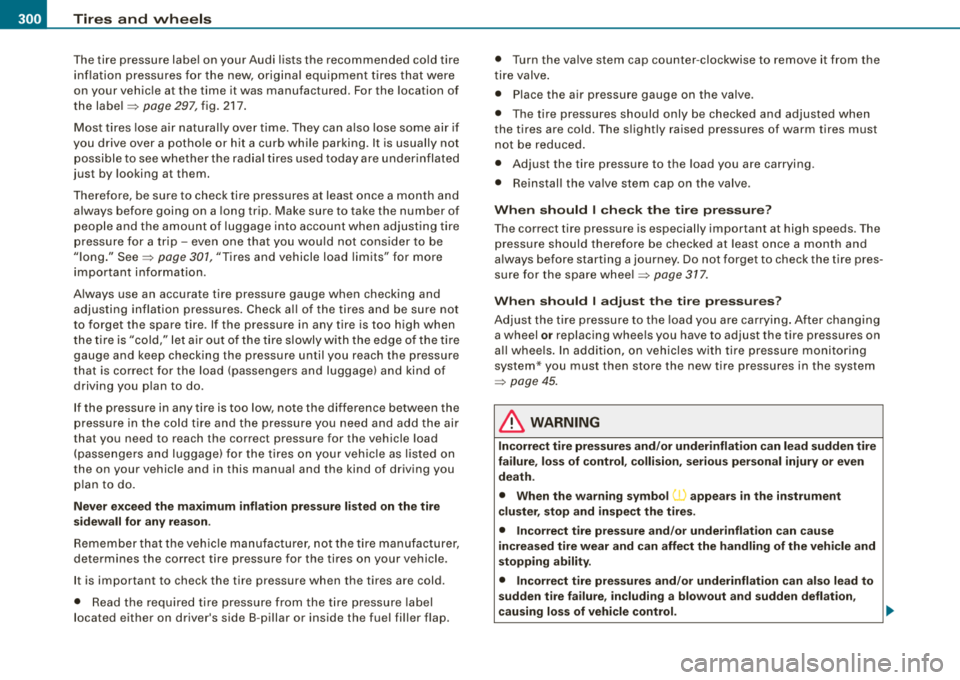
___ T_ ir_e _ s_ a_ n
_ d_ w_ h_ e_ e_ls _________________________________________________ _
The tire pressure label on your Audi lists the recommended cold tire
inf lation pressures for the new, original equipmen t tires that were
on your vehic le at the time it was manufactured . For the location of
the
labe l=> page 297, fig. 217 .
Most tires lose a ir natural ly over time. They can a lso lose some air if
you drive over a potho le or hit a curb wh ile parking. It is usually not
possible to see whether the radial t ires used today are under inflated
just by looking at them.
Therefore, be su re to check tire pressures at least once a month and
always before going on a long trip . Make sure to take the number of
people and the amount of luggage into account when adjusting tire
pressure for a trip -even one that you wou ld not cons ider to be
" long ."
See => page 301, "Tires and vehicle load limits" for more
important i nformation .
A lways use an accurat e tire pressure gaug e when checking and
adjusting inflat ion pressures. Check a ll of the tires and be sure not
to forget the spare tire . If the pressure in any tire is too high when
the t ire is "cold," let air o ut of the t ire slowly with the edge of the tire
gauge and keep check ing the pressure until you reach the pressure
that is correct for the load (passengers and luggage) and kind of
driving you p lan to do .
I f the pressure in any tire is too low, note the difference between the
pressure in the co ld tire and the pressure you need and add the air
that you need to reach the correct pressure for the vehicle load
(passengers and luggage) fo r the t ires on your veh ic le as listed on
the on your vehicle and in this manual and the kind of driving you pl an to do .
Never exceed the m aximum inflation pressure li sted on the tire
s idewall for an y re ason .
Remem ber that the vehic le manufacturer, not t he tire manufacturer,
determines the correct tire pressure for the tires on your vehicle .
I t is important to check the tire pressure when the tires are cold.
• Read the required tire pressure from the t ire pressure label
located either on driver 's side B -pillar or inside the fuel fi ller flap . •
Turn the va lve stem cap counter -clockwise to remove it from the
t ire valve .
• Place the air pressure gauge on the valve.
• The tire pressures should only be checked and adjusted when
the tires are cold. The s lightly raised pressures of warm tires must
not be reduced.
• Adjust the tire pressure to the load you are carrying.
• Reinstal l the va lve stem cap on the valve .
When should I check the tire pressure?
The correct tire pressure is especially important at high spe eds . The
pressure should the refore be checked at least once a mo nth and
a lways before starting a journey. Do not forget to check the tire pres
sure for the spare whee l
=> page 317.
Wh en should I adjust th e tir e pre ssur es?
Adjust t he tire pressure to the load you are carry ing . After changing
a wheel
o r replacing whee ls you have to ad just the tire pressures on
a ll whee ls . In addition, on vehicles w ith tire pressure monito ring
system* you must then store the new tire pressures in the system
=> page 45.
& WARNING
Incorrect tire pre ssure s and /or underinflation can lead sudden tire
f ai lure , loss of control , collision , seri ous per sonal injury or even
death.
• When the w arning symbol
(l) appe ars in the in strument
clu ster , stop and inspect the tire s.
• Incorrect t ire pres sure and /or underinflat ion can cause
increa sed tire wear and can affect the handling of the vehicle and
s topping ability.
• Incorrect tire pres sures and /or underinflation can also lead to
s udden tire fa ilure , inc luding a blowout and sudden defl ation ,
cau sing los s of vehicle control .
~
Page 303 of 368
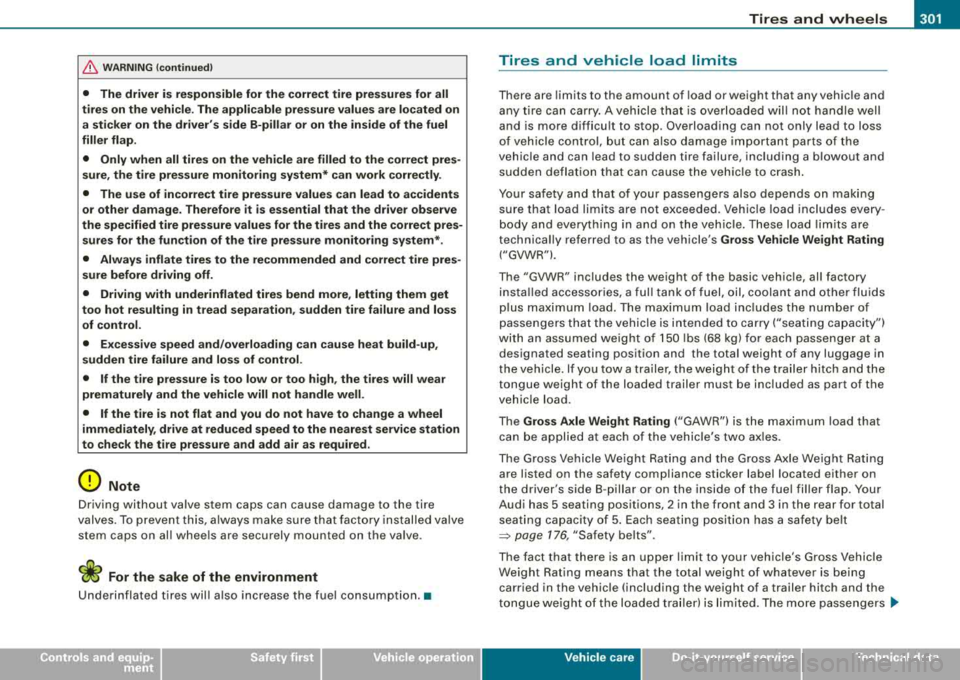
________________________________________________ T_ i
_ r_e _s_ a_n_ d_ w_ h_ e_e _ l_s __ l'III
& W ARNING (continued )
• The driver is respon sible for the correct tire pre ssure s for all
tire s on the vehicle. The applicable pressure values are located on
a st icker on the driver 's side B-pillar or on the inside of the fuel
filler flap.
• Only when all tire s on the vehicle are filled to the correct pres
sure , the tire pressure monitoring system * can work correctly .
• The use of incorrect tire pressure values can lead to accidents
or other damage. Therefore it is essential that the driver observe
the specified tire pressure values for the tires and the correct pres
sures for the function of the tire pressure monitoring system*.
• Always inflate tires to the recommended and correct tire pres
sure before driving off.
• Driving with underinflated tires bend more , letting them get
too hot resulting in tread separation , sudden tire failure and loss
of control.
• Ex cessive speed and /overloading can cause heat build -up ,
sudden tire failure and loss of control .
• If the tire pressure is too low or too high, the tires will wear
prematurely and the vehicle will not handle well.
• If the tire is not flat and you do not have to change a wheel
immediately, drive at reduced speed to the nearest service station
to che ck the tire pressure and add air as required .
0 Note
Driving without valve stem caps can cause damage to the tire
valves. To preve nt th is, a lways make s ure th at f acto ry installed va lve
stem caps on al l whee ls are securely mounted on the va lve .
~ For the sake of the environment
Underinflated tires will a lso increase the fuel consumpt io n. •
Tires and vehicle load limits
There are limits to the amount of load or weight t hat any vehic le and
any tire can carry . A ve hicle that i s ove rloa ded will not handle well
and is more d iff icu lt to stop . Overload ing can not only lead to loss
o f vehi cle control, but can also damag e impor tan t p arts o f the
vehic le and can lead to sudden tire failure, including a blowout and
sudde n defla tion that ca n cause the veh ic le to c ra sh .
Your sa fety a nd t hat o f your passe ngers a lso depe nds o n maki ng
s u re that load li mits are not exceeded. Vehic le load incl udes every
b ody and everythi ng i n and on t he vehicle . T he se l oa d limi ts are
technical ly referred to as the ve hic le's
Gross Vehicle Weight Rating
("GVW R"l.
T he "GVWR" includes the wei ght of the basic vehic le, all factory
in sta lled acces so ries, a full t an k of f uel, o il, c oolant a nd oth e r flu ids
p lus max imum load . T he maximum load inc ludes th e number o f
p asse ngers tha t th e ve hicle i s intended t o carry ("seat ing ca paci ty")
with an assu med weight o f 150 l bs (68 kg) fo r each passe nger at a
designated seating position and the total weight of any luggage in
th e v ehic le. I f you tow a trai ler, the we ig ht o f the tra iler hitch a nd th e
tongue weight of the loaded trailer must be inc luded as part of the
ve hicle lo ad .
The
Gross Axle Weight Rating ("GAWR") is t he maximum load that
ca n b e app lie d at eac h of th e veh icle's two axle s.
T he G ross Ve hicle We ight Rati ng a nd th e G ross A xle Wei ght R ati ng
are listed on the safety comp liance stic ker label located either on
t he driver 's si de B-pi lla r o r on the in sid e of t he fue l fille r fl ap. You r
Aud i has 5 seating posit ions, 2 in the front and 3 in the rear for total
sea ting ca paci ty of 5. Each sea ting p osit ion has a safe ty b elt
=> page 176, "Saf ety be lts" .
The fact that there is an upper limit to your vehicle's Gro ss Vehicle
W eight Rat ing m eans that th e total weight o f whatever is b ein g
carried in the vehic le (including the weight of a traile r hitc h and the
ton gue we ight of the loaded tr aile r) is lim it e d. Th e m or e passe ng ers
~
Vehicle care
Page 304 of 368
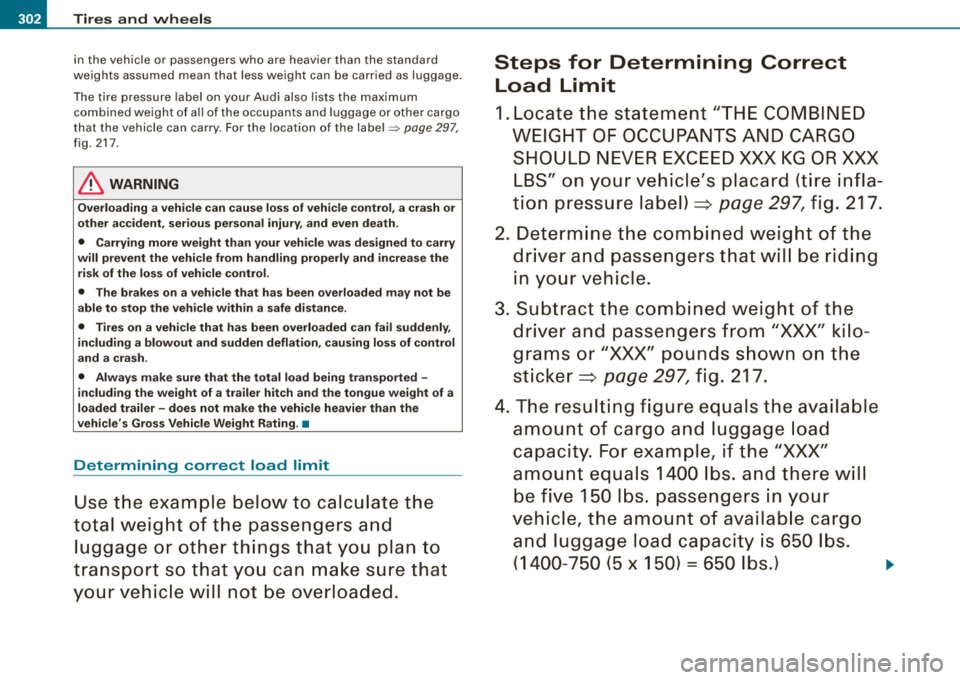
11!1 Tires and wheels
in the vehicle or passengers who are heavier than the standard
we ig ht s assume d mean that less weig ht ca n be carr ied as luggage.
T he tire pressure labe l on your Audi also lists the max imum
combined weight of a ll of t he occupants and luggage or other cargo
t h at t he ve hicle ca n ca rry. For t he location of t he
labe l~ page 2 97,
fig. 217.
LJ}. WARNING
Overloading a vehicle can cause loss of vehicle control, a crash or
other accident , serious personal injury, and even death .
• Carrying more weight than your vehicle was designed to carry
will prevent the vehi cle from handling properly and in crease the
risk of the loss of vehicle control.
• The brakes on a vehi cle that has been overloaded may not be
able to stop the vehicle within a safe distance .
• Tires on a veh icle that has been overloaded can fail suddenly ,
including a blowout and sudden deflation , causing loss of control
and a cra sh .
• Always make sure that the total load being transported -
including the weight of a trailer hitch and the tongue weight of a
loaded trailer -does not make the vehicle heavier than the
vehi cle 's Gro ss Vehicle Weight Rating .•
Determining correct load limit
Use the example below to calculate the
total weight of the passengers and luggage or other things that you plan to
transport so that you can make sure that
your vehicle will not be overloaded.
Steps for Determining Correct Load Limit
1. Locate the statement "THE COMBINED
WEIGHT OF OCCUPANTS AND CARGO SHOULD NEVER EXCEED XXX KG OR XXX
LBS " on your vehicle's placard (tire infla
tion pressure
label) => page 297, fig. 217.
2. Determine the combined weight of the driver and passengers that will be riding
in your vehicle.
3. Subtract the combined weight of the driver and passengers from
"XXX" kilo
grams or
"XXX" pounds shown on the
sticker=> page 297 , fig. 217.
4. The resulting figure equals the available amount of cargo and luggage load capacity. For example, if the
" XXX"
amount equals 1400 lbs. and there will
be five 150 lbs. passengers in your
vehicle, the amount of available cargo
and luggage load capacity is 650 lbs. (1400 -750 (5
X 150) = 650 lbs.) ..
Page 305 of 368
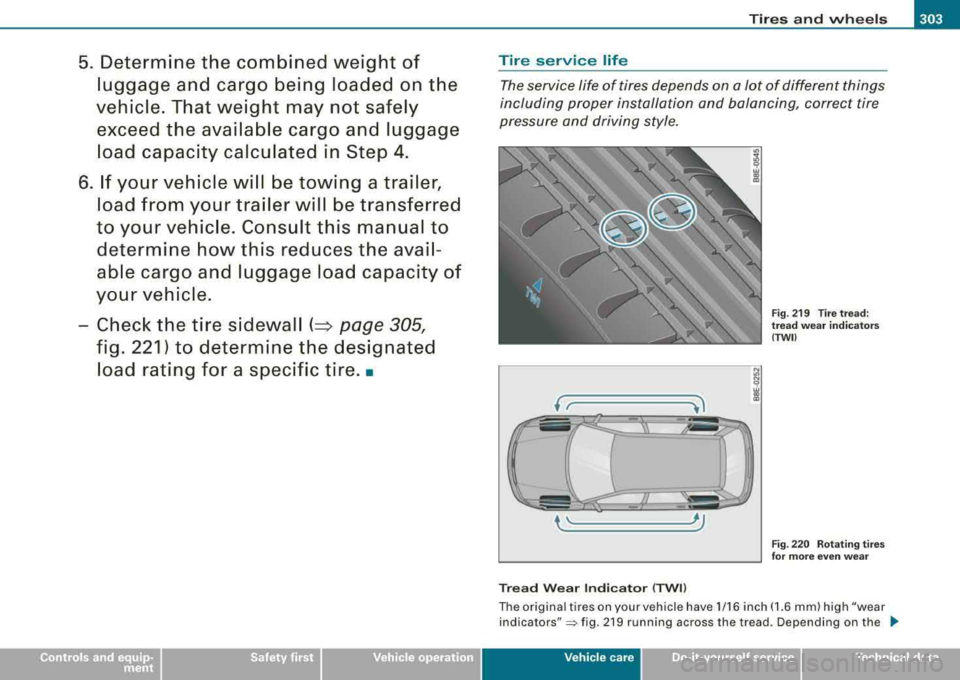
5. Determine the combined weight of luggage and cargo being loaded on the
vehicle. That weight may not safely
exceed the available cargo and luggage
load capacity calculated in Step 4.
6. If your vehicle will be towing a trailer, load from your trailer will be transferred
to your vehicle. Consult this manual to
determine how this reduces the avail
able cargo and luggage load capacity of
your vehicle.
- Check the tire sidewall(::::>
page 305,
fig. 221) to determine the designated
load rating for a specific tire.•
Tires and wheels 1111
Tire service life
The service life of tires depends on a lot of different things
including proper installation and balancing, correct tire
pressure and driving style.
•,
.._ ____________ __,
Tread Wear Indicator {TWI)
Fig. 219 Tire tread:
tread wear indicators
(TWO
Fig . 220 Rotating tires
for more even wear
The origina l tires on your vehicle have 1 /16 inch (1.6 mm) high "wear
indicators"=> fig . 219 running across the tread . Depending on the .,.
Vehic le care irechnical data
Page 306 of 368
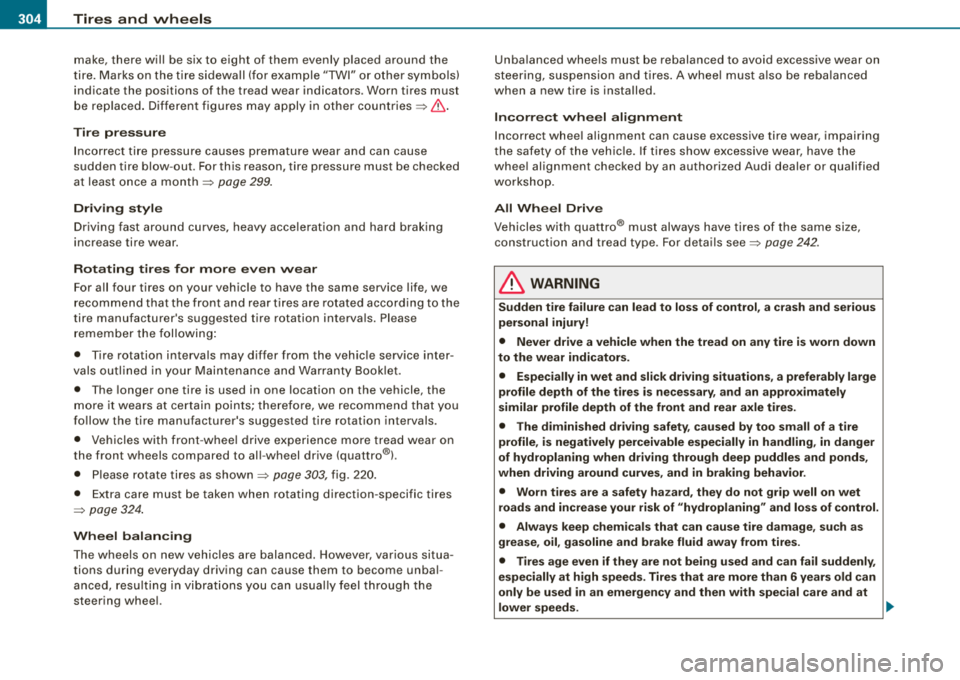
___ T_ ir_e _ s_ a_ n
_ d_ w_ h_ e_ e_ls _________________________________________________ _
make, there w ill be six to eight of t hem evenly p laced around the
tir e. M arks o n the tire s idewall ( for example "TWI " or oth er sy mb ols)
indicate th e positions of the tread wear indicators. Worn tires must
b e re placed . Di fferen t fig ure s m ay apply i n other
c ountr ies=> & .
Tire pressure
Incorr ect tir e p ress ure c auses prematu re wear a nd can ca use
sudden tir e blow -out . For th is r eason, tir e pressur e must b e check ed
at leas t once a month
=> pa ge 299 .
Dri ving style
Drivi ng fa st aro und curv es, heavy acce le ra ti on and ha rd bra kin g
increase tire wear .
Rotating tires for more even wear
For all four tires on your vehic le to have the same service life, we
r ecom mend t hat the front a nd rea r tires ar e rotate d accord ing to the
tire manufacturer 's suggested tire rotation interva ls. Please
r e m emb er t he fo llo wi ng :
• Ti re rotation interva ls m ay d iffer from th e vehic le servic e inter
vals outl ined in y our M aintenance and Warran ty Boo kle t.
• T he longer one tire is used in one location on the vehicle, the
mor e it wea rs a t ce rtain points ; the re fo re, we rec omm end that yo u
fo llow t he ti re manufactu rer's su ggested tir e rotat ion int ervals .
• Vehi cle s with front -wh eel d rive e xper ience mo re trea d wea r on
the front wheels compared to al l-wheel drive (quattro®l .
• Ple as e ro tat e ti res as
sh ow n=> page 303, fig. 220.
• Extra care must be taken when rotating direction -specific tires
=> pag e 32 4.
Wheel balancing
T he wheels on n ew vehic les are bala nced. However, various situa
tions during eve ryday driving can cause them to become unba l
ance d, res ulting i n vi brat ions you ca n us ual ly f eel thro ugh t he
steering whee l. U
nba lanc ed wh eels must be rebalanced to avoid excessive wear on
s tee ring, s uspen sio n an d tir es. A w heel m ust also be reba la nced
when a new tire is install ed.
Incorrect wheel alignment
Incorrect whee l alignment can cause excessive tire wear, impairing
t he sa fety o f the vehicl e. If ti res sh ow ex cessiv e w ear, h av e the
whee l al ignm ent check ed by an autho riz ed Aud i d eal er or qualifi ed
w ork shop.
All Wheel Drive
Ve hicl es wi th qu attr o® must alw ays h ave t ires of t he sa me siz e,
construction and tread type . For deta ils
see=> page 242 .
& WARNING
Sudden tire failure can lead to loss of control , a crash and serious
personal injury!
• Never drive a vehicle when the tread on any tire is worn down
to the wear indicators .
• Especially in wet and slick driving situations , a preferably large
profile depth of the tires is necessary , and an approximately
similar profile depth of the front and rear axle tires.
• The diminished driving safety , caused by too small of a tire
profile, is negatively perceivable especially in handling , in danger
of hydroplaning when driving through deep puddles and ponds,
when driving around curves , and in braking behavior.
• Worn tires are a safety hazard , they do not grip well on wet
roads and increase your risk of "hydroplaning" and loss of control.
• Always keep chem icals that can cause tire damage , such as
grease, oil, gasoline and brake fluid away from tires .
• Tires age even if they are not being used and can fail suddenly ,
especially at high speeds. Tires that are more than 6 years old can
only be used in an emergency and then with special care and at
lower speeds .
~
Page 307 of 368
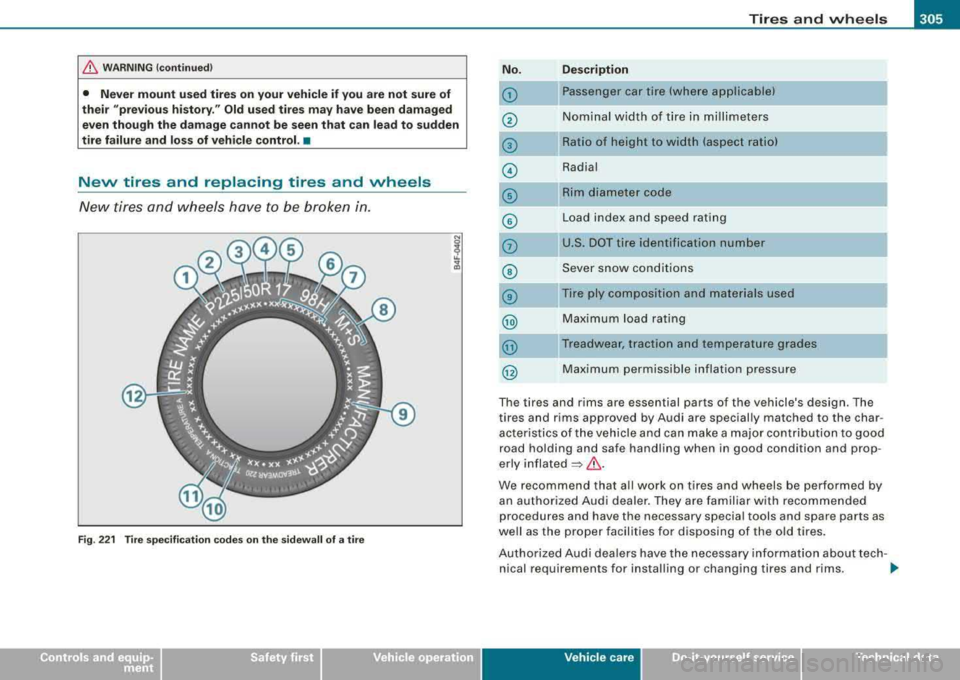
__________________________________________________ T_ ir_e _ s_ a_ n
_ d_ w_ h_ e_ e_ls _ __. 11111
/b, W ARNING (continued )
• Never mount u sed tires on your vehicle if you are not sure of
their "previou s history. " Old used ti res may ha ve been damaged
even though the damage cannot be seen that can lead to sudden
tire failu re and loss of vehicle control.
•
New tires and replacing tires and wheels
N ew tires and wheels have to be bro ken i n.
12
9
Fig . 22 1 Tire spe cificati on code s on the sidewall of a tire
No .
0
@
®
©
©
Description
Passenger car tire (where applicable)
Nominal w idth o f tire in mi llime ters
Ratio of height to width (aspect ratio)
Radia l
Rim diameter code
© Load index and speed rating
0
©
©
@)
1ju.s. DOT tire identification number
Sever snow cond itions
Tire ply composition and materials used
Max imu m load rating
@ Treadwear, traction and temperature grades
@ Maximum permissible inflation pressure
The t ires and rims are ess ential parts of the ve hicle's design . T h e
tires and rims approved by Audi are specially matched to the char
ac ter is ti cs of th e vehicle and can mak e a major contribution to good
road holding and safe hand ling when in good condition and prop
erly i nflated
=> /b, .
We recommend that a ll work on tires and wheels be perfo rmed by
an au thorized Audi dealer . They a re familia r with recommended
procedures and have the necessary specia l tools and spare parts as
we ll as the proper facilities fo r dispo sing of the o ld tires.
Authori zed Audi d ea lers have the n ecessa ry in for mati on abo ut tec h-
nical requirements for instal ling or changing tires and rims . _...
Vehic le care Technical data
Page 308 of 368
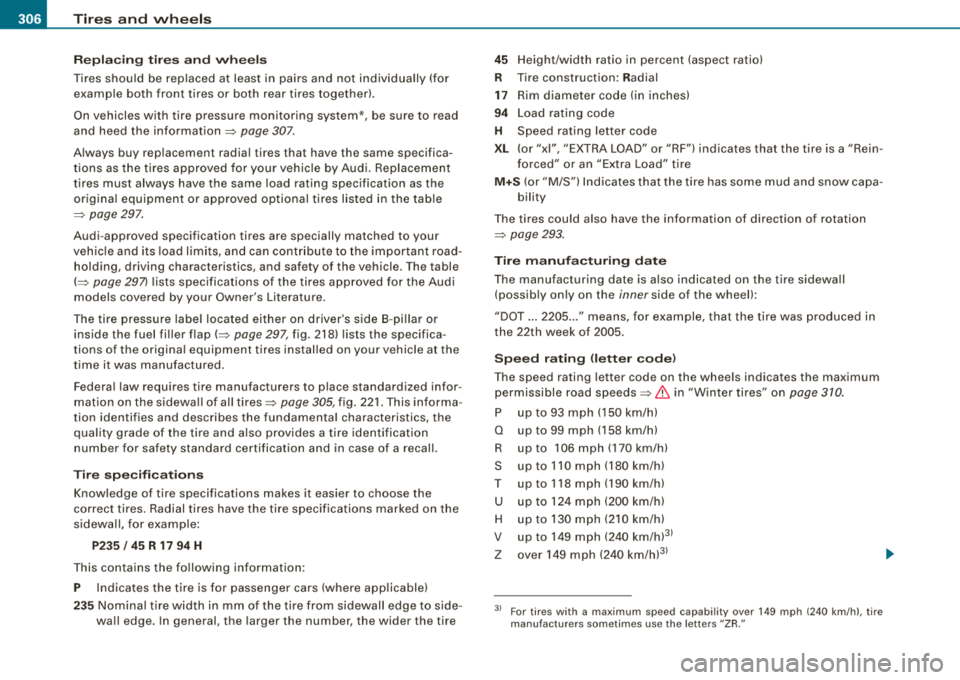
___ T_ ir_e_ s_ a_ n
_ d_ w_ h_ e_ e_l_
s _________________________________________________ _
R ep laci ng tires a nd whee ls
T ires shou ld be replaced at least in pairs and not ind ividually (for
examp le bo th front tires or both rear tires together!.
On v ehicles with tire pressure monitoring system *, be sure to read
and heed the informat ion
=> page 307.
A lways buy rep lacement radia l tires that have the same sp ecifica
t ions as the tires approved for your veh ic le by Aud i. Replacement
tires must always have the same load rating specification as the
orig ina l equipment or approved optional t ires listed in the table
=> page 297.
Audi -approved specification tires are specially matched to your
vehic le and its load limits, and can contribute to the important road
holding, driving characteristics, and safety of the vehicle . The table
(=> page 297) lists specifications of the tires approved for the Audi
models covered by your Owner's Literature .
The tire pressure labe l located either on driver 's side 8 -pi llar or
inside the fuel fi ller
flap(=> page 297, fig. 218) lists the specifica
tions of the origina l equipment tires installed on your vehicle at the
time it was manufactured .
Federa l law requires tire manufacturers to place standardized infor
mation on the s idewall of all
tires => page 305, fig. 221 . This informa
tion identifies and describes the fundamental characteristics, the quality grade of the tire and a lso provides a tire identification
number for safety standard certification and in case of a recall.
Tir e specificat ions
Knowledge of tire specifications makes it easier to choose the
correct tires . Ra dial t ires have the tire specifications marked o n the
sidewall, for example :
P235 / 45 R 1 7 94 H
This contains the following informat ion:
P Indicates the tire is for passenger cars (where app licable)
2 35 No minal t ire wid th i n mm of the tire fro m sidewall edge to side
wall edge. In general, the larger the number, the wider the tire
45 Height/width ratio in percent (aspect ratio)
R Tire construction: Radial
17 Rim diameter code (in inches)
94 Load rat ing code
H Speed rating letter code
X L (or "xi", "EXTRA LOAD" or "RF") indicates that the t ire is a "Rein
forced" or an "Extra Load" ti re
M +S (or "M/S") Ind icates that the tire has some mud and snow capa -
bility
The tires cou ld also have the information of direction of rotation
=> page 293.
Tire m anuf acturing date
The manufacturing date is a lso indicated on the tire sidewall
(possibly on ly on the
inner side of the wheel):
"DOT ... 2205 . ..
" means, for example, that the tire was produced in
the 22th week of 2005.
S peed r ating (le tt e r code )
The speed rating letter code on the whee ls indicates the maximum
permissible road
speeds => & in "W inter tires" on page 310 .
p up to 93 mph ( 150 km/h)
Q up to 99 mph (158 km/h)
R up to 106 mph (170 km/h)
s up to 110 mph (180 km/h)
T up to 118 mph (190 km/h)
u up to 124 mph (200 km/h)
H up to 130 mph (210 km/
h)
V up to 149 mph (240 km/h)3
l
z over 149 mph (240 km/h)31
3> For tires w ith a maximum speed capabi lity over 149 mph (240 km/h) , tire
manufacturers sometimes use the letters " ZR."
Page 309 of 368
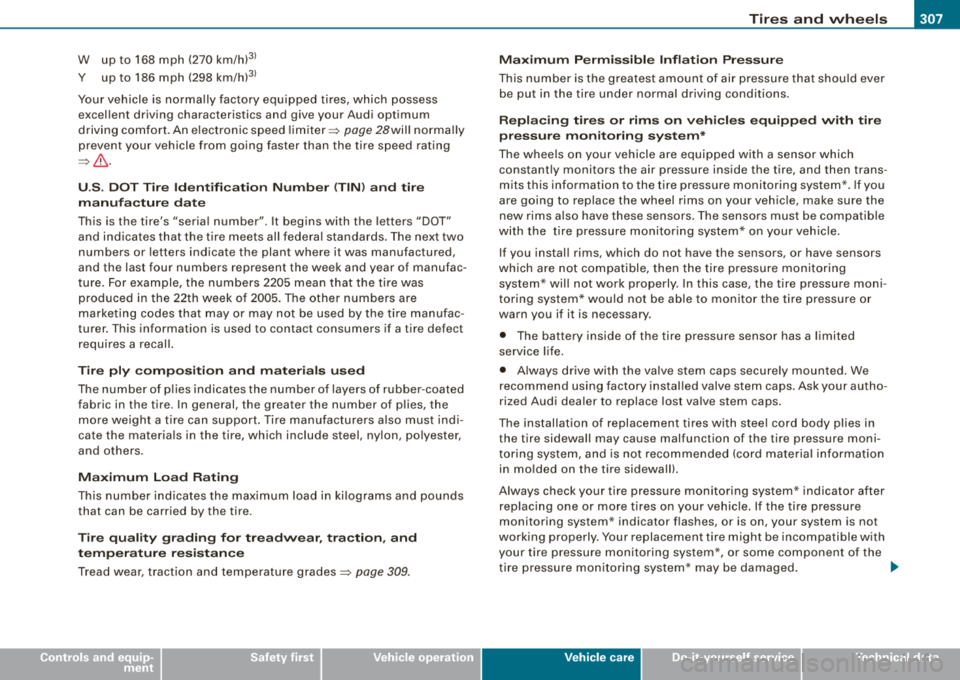
________________________________________________ T_ i
_ r_e _s_ a_n_ d_ w_ h_ e_e _ l_s __ l!III
W up to 168 mph (270 km/h)3
)
Y up to 186 mph (298 km/h)3
l
Your vehicle is normally factory equipped tires, which possess
excellent driving characteristics and give your Audi optimum
driving comfort. An electronic speed
limiter => page 28will normally
prevent your vehicle from going faster than the tire speed rating
=> & .
U .S. DOT Tire Identification Number (TIN) and tire
manufacture date
This is the tire's "serial number". It begins with the letters "DOT"
and indicates that the tire meets all federal standards. The next two
numbers or letters indicate the plant where it was manufactured,
and the last four numbers represent the week and year of manufac
ture . For example, the numbers 2205 mean that the tire was
produced in the 22th week of 2005. The other numbers are
marketing codes that may or may not be used by the tire manufac
turer. This information is used to contact consumers if a tire defect
requires a recall.
Tire ply composition and materials used
The number of plies indicates the number of layers of rubber-coated
fabric in the tire. In general, the greater the number of plies, the
more weight a tire can support. Tire manufacturers also must indi
cate the materials in the tire, which include steel, nylon, polyester,
and others.
Maximum Load Rating
This number indicates the maximum load in kilograms and pounds
that can be carried by the tire.
Tire quality grading for treadwear, traction, and
temperature resistance
Tread wear, traction and temperature grades=> page 309 . Maximum Permissible Inflation Pressure
This number is
the greatest amount of air pressure that should ever
be put in the tire under normal driving conditions.
Replacing tires or rims on vehicles equipped with tire
pressure monitoring system*
The wheels on your vehicle are equipped with a sensor which
constantly monitors the air pressure inside the tire, and then trans
mits this information to the tire pressure monitoring system*. If you
are going to replace the wheel rims on your vehicle, make sure the
new rims also have these sensors. The sensors must be compatible
with the tire pressure monitoring system* on your vehicle.
If you install rims, which do not have the sensors, or have sensors
which are not compatible, then the tire pressure monitoring
system * will not work properly. In this case, the tire pressure moni
toring system* would not be able to monitor the tire pressure or
warn you if it is necessary .
• The battery inside of the tire pressure sensor has a limited
service life.
• Always drive with the valve stem caps securely mounted. We
recommend using factory installed valve stem caps . Ask your autho
rized Audi dealer to replace lost valve stem caps.
The installation of replacement tires with steel cord body plies in
the tire sidewall may cause malfunction of the tire pressure moni
toring system, and is not recommended (cord material information
in molded on the tire sidewall).
Always check your tire pressure monitoring system* indicator after
replacing one or more tires on your vehicle. If the tire pressure
monitoring system * indicator flashes, or is on, your system is not
working properly. Your replacement tire might be incompatible with
your tire pressure monitoring system*, or some component of the
tire pressure monitoring system* may be damaged.
....
Vehicle care
Page 310 of 368
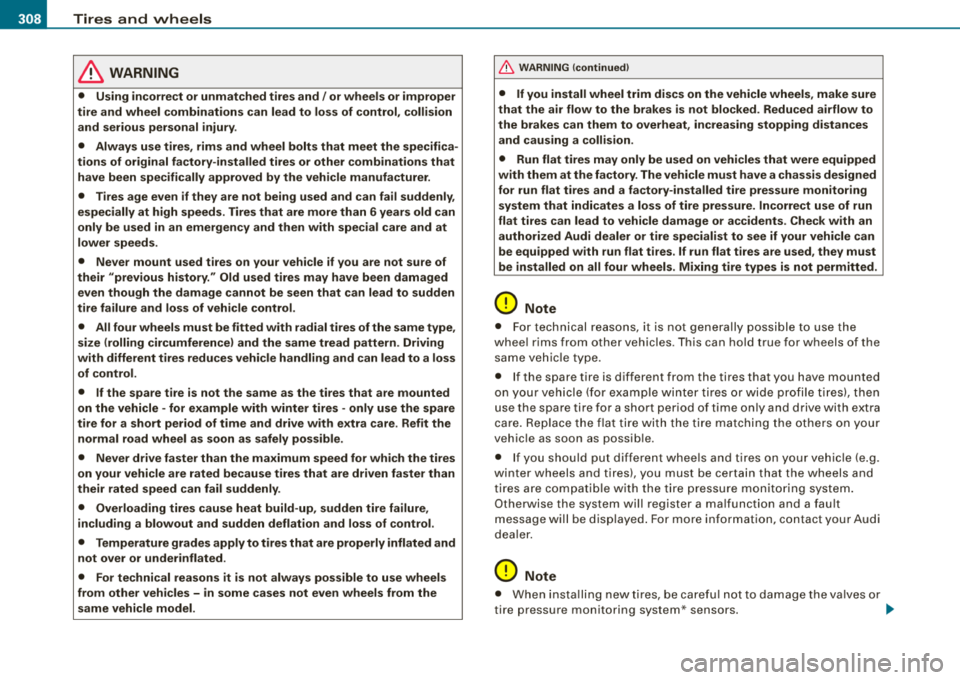
___ T_ ir_e _ s_ a_ n
_ d_ w_ h_ e_ e_ls _________________________________________________ _
& WARNING
• Using incorrect or unmatched tires and / or wheels or improper
tire and wheel combinations can lead to loss of control , collision
and serious personal injury .
• Always u se tires , rims and wheel bolts that meet the specifica
tions of original factory -installed tires or other combinations that
have been specifically approved by the vehicle manufacturer.
• Tires age even if they are not being used and can fail suddenly ,
especially at high speeds . Tires that are more than 6 years old can
only be used in an emergen cy and then with special care and at
lower speed s.
• Never mount used tires on your vehi cle if you are not sure of
their "previous history." Old used tires may have been damaged
even though the damage cannot be seen that can lead to sudden
tire failure and loss of vehicle control.
• All four wheels must be fitted with radial tires of the same type ,
size (rolling circumference ) and the same tread pattern. Driving
with different tires reduces vehi cle handling and can lead to a loss
of control.
• If the spare t ire is not the same as the tires that are mounted
on the vehicle -for example with winter tires -only use the spare
tire for a short period of time and drive with extra care . Refit the
normal road wheel as soon as safely possible.
• Never drive faster than the ma ximum speed for wh ich the tires
on your vehicle are rated because tires that are driven faster than
their rated speed can fail suddenly .
• Overloading tire s cause heat build -up , sudden tire failure ,
including a blowout and sudden deflation and loss of control.
• Temperature grades apply to tires that are properly inflated and
not over or underinflated .
• For technical reasons it is not always possible to use wheel s
from other vehicles - in some cases not even wheels from the
same vehicle model.
& WARNING (continued )
• If you install wheel trim discs on the vehicle wheels, make sure
that the air flow to the brakes is not blocked . Reduced airflow to
the brakes can them to overheat , increasing stopping distances
and causing a collision .
• Run flat tires may only be used on vehicles that were equipped
with them at the factory. The vehicle must have a chassis designed
for run flat tires and a factory-installed tire pressure monitoring
s ystem that indicate s a loss of tire pressure . Incorrect use of run
flat tires can lead to vehicle damage or ac cidents . Check with an
authorized Audi dealer or tire specialist to see if your vehicle can
be equ ipped with run flat tires . If run flat tires are used , they must
be installed on all four wheels . Mixing tire types is not permitted.
0 Note
• For tec hnical r eas ons, it is no t gene rally possible to use the
whee l rims from other vehicles . ihis can hold true for wheels of the
same ve hicle type.
• I f the spare tire is different from the tires that you have mounted
on y our ve hicle (f or exampl e wi nter t ires or wide p ro fi le tir es), then
use the spa re tire fo r a short per iod of time on ly and d rive with extra
c a re . Rep lace the flat t ire wi th the ti re m atc h ing t he oth ers o n you r
vehic le as soon as possib le .
• If yo u should put diff eren t w heels a nd tires on yo ur vehi cle (e. g.
winter wheels and tires), you must be certa in that the wheels and
t ires a re co mpatibl e w ith the tire press ur e m onit orin g sys te m.
Otherwise the system will regist er a ma lfunction and a fau lt
mes sage wil l be d isp layed . Fo r mo re info rmation, contact yo ur Audi
dea ler .
0 Note
• When i nsta lling new ti res, be care fu l n ot to damage t he va lves o r
tire press ure mon itoring system* sensors . .,_